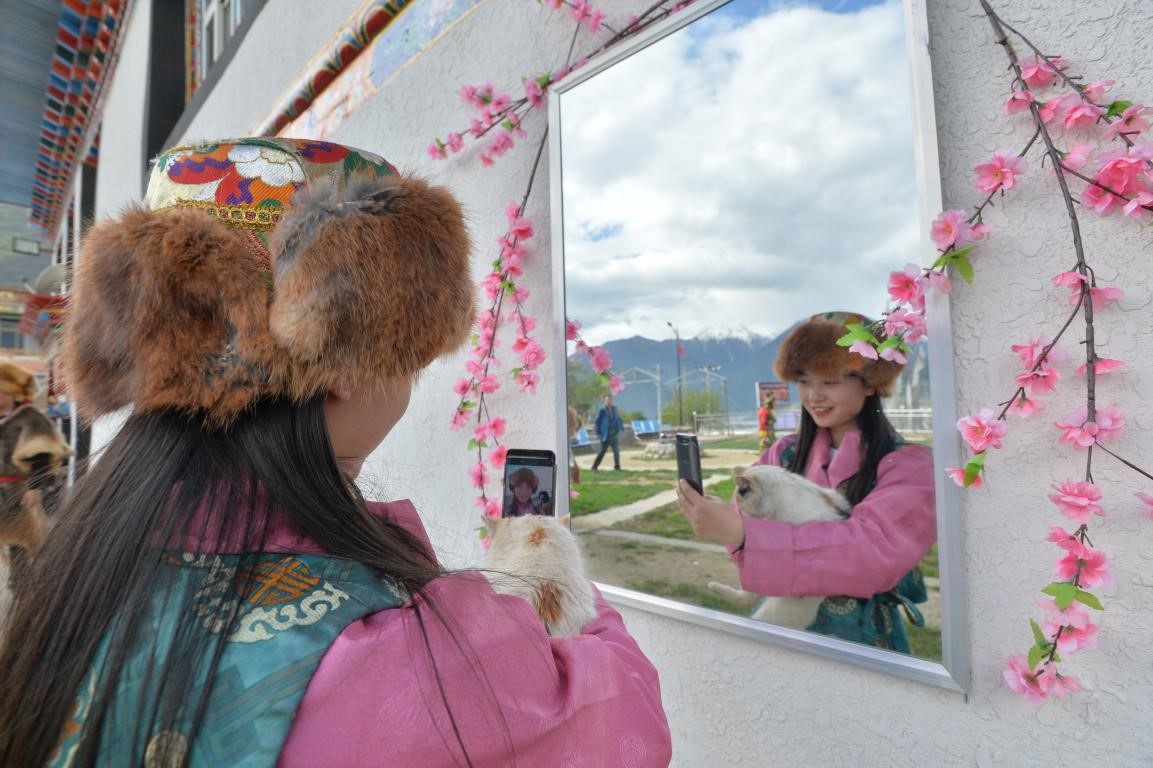

Southwest China’s Tibet Autonomous Region, the only provincial-level region among China’s 14 national contiguous impoverished regions suffering from extreme poverty, has taken greats efforts to help farmers and herdsmen out of poverty.

Photo taken on May 18, 2019 shows a visitor in traditional Tibetan costume takes photos at a homestay in Suosong village, Paizhen township, Milin county, Nyingchi city of southwest China’s Tibet Autonomous Region. (Photo by Qiao Qiming/People’s Daily Online)
With flocks of sheep and cattle as well as golden highland barley, Tibet is especially lovely during autumn and winter. Right after reaping highland barley, 45-year-old Chodron in Dagze District, Lhasa, capital of Tibet, hurried to a farmers and herdsmen cooperative that produces and sells handmade traditional handicrafts.
Chodron is a seamstress at the cooperative. Recently, she and her workmates have been working overtime as the cooperative received a great number of orders for school uniforms. In the past, she became idle after the harvest time.
Established in 2012, the cooperative has provided jobs for 27 farmers and herdsmen like Chodron and brings them a monthly income between 2,800 yuan (about $394.49) and 6,000 yuan.
“In the recent three years, we have developed suitable poverty alleviation industries to help farmers and herdsmen increase their income,” said Zhang Gan, secretary of the Communist Party of China Dagze District committee.
Zhang added that in the first half of this year, the per capita disposable income of rural residents in Dagze District reached 4,623 yuan, more than 75 percent of which was generated by industries and paid by employers, representing a significant increase from the past.
Five years ago, policy-generated income accounted for about 40 percent of the per capita disposable income of rural residents in the district.
In the first half of 2019, the per capita disposable income of rural residents in Tibet was 4,009 yuan, up 12.5 percent year on year, which represented the greatest growth rate of per capita disposable income among provincial-level areas in the whole country. In particular, the per capita income from wages and salaries of rural residents grew by 47.3 percent.

Villagers of the poverty-stricken Baka village, Bomi county, Nyingchi city of southwest China’s Tibet Autonomous Region harvest highland barley, a main cash crop, so as to process and sell the products at an early date. (Photo by Lu Wenkai/People’s Daily Online)
While developing industries with local characteristics such as yak, highland barley, mineral water and handicrafts with ethnic minority characteristics, Tibet has managed to train farmers and herdsmen and create jobs for them.
The region has properly integrated the development of industries and local employment, helping farmers and herdsmen find jobs in areas closer to home and enabling them to fully share development dividends.
According to credible source, various infrastructure construction projects in Tibet in the first half of this year had created jobs for 193,000 farmers and herdsmen, thus significantly increasing rural residents’ income.
Currently, poverty headcount ratio in Tibet has dropped to less than 6 percent. In this year, the region aims to increase the disposable income of rural residents by more than 13 percent, and lift all the 150,000 people living in poverty and all the 19 impoverished counties out of poverty.
 Fire brigade in Shanghai holds group wedding
Fire brigade in Shanghai holds group wedding Tourists enjoy ice sculptures in Datan Town, north China
Tourists enjoy ice sculptures in Datan Town, north China Sunset scenery of Dayan Pagoda in Xi'an
Sunset scenery of Dayan Pagoda in Xi'an Tourists have fun at scenic spot in Nanlong Town, NW China
Tourists have fun at scenic spot in Nanlong Town, NW China Harbin attracts tourists by making best use of ice in winter
Harbin attracts tourists by making best use of ice in winter In pics: FIS Alpine Ski Women's World Cup Slalom
In pics: FIS Alpine Ski Women's World Cup Slalom Black-necked cranes rest at reservoir in Lhunzhub County, Lhasa
Black-necked cranes rest at reservoir in Lhunzhub County, Lhasa China's FAST telescope will be available to foreign scientists in April
China's FAST telescope will be available to foreign scientists in April "She power" plays indispensable role in poverty alleviation
"She power" plays indispensable role in poverty alleviation Top 10 world news events of People's Daily in 2020
Top 10 world news events of People's Daily in 2020 Top 10 China news events of People's Daily in 2020
Top 10 China news events of People's Daily in 2020 Top 10 media buzzwords of 2020
Top 10 media buzzwords of 2020 Year-ender:10 major tourism stories of 2020
Year-ender:10 major tourism stories of 2020 No interference in Venezuelan issues
No interference in Venezuelan issues
 Biz prepares for trade spat
Biz prepares for trade spat
 Broadcasting Continent
Broadcasting Continent Australia wins Chinese CEOs as US loses
Australia wins Chinese CEOs as US loses